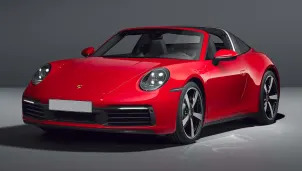2023 Porsche 911
THERMAL CLUB, Calif. — “Insufficient lateral support” isn’t exactly a common criticism that’s been levied at Porsche’s hardcore Full-Bucket Seat option. More like, “These need more padding,” or “Seriously, these don’t recline?” Yet, when popped into the 2023 Porsche 911 GT3 RS, the normally snug carbon-fiber uber-sport seats could suddenly benefit from even more support as the car furiously assaults each turn. And your body, too, because unless you’re a pro race driver, fighter pilot or astronaut, there’s a very good chance you haven’t helmed a vehicle capable of these types of G forces, either. You see, this ultra 911’s multitude of aerodynamic elements flatten it to the road with more than twice the downforce (895 pounds) than the outgoing GT3 RS when going 124 mph, which we did here at the Thermal Club. Had we been able to manage 177 mph, it would’ve created 1,003 more pounds of downforce for a shake-your-head-absurd 1,896 pounds. That’s similar to Porsche’s previous-generation GTE LeMans race cars. So yeah, that enormous wing on the back isn’t just to impress the “Fast and Furious” crowd. It’s still damn impressive, though. At 40% larger than the outgoing GT3 RS swan-neck wing, it’s the first time a Porsche road car’s wing is taller than the roof line. Not only that, it consists of two pieces, with a fixed portion and a hydraulically controlled, continuously adaptable element with an adjustment range of 34 degrees. It can’t get all the credit, though: The rear wing works in concert with a similarly adaptive underbody spoiler hidden up front, little fins mounted to the fully paneled underbody, and a rear diffuser. Even the front suspension’s double wishbones were stamped into a teardrop profile to increase front axle downforce by about 88 pounds. And we’re just getting started. The rest of the great-many winglets, vents and cutouts further add downforce or ensure proper cooling. Those embedded within the giant hood vents guide hot air out of the unique single radiator that fills the space normally occupied by the 911’s frunk (the previous GT3 RS had three separate radiators). The novel roof fins are then crucial for ensuring that hot air doesn’t continue on into the engine’s air intakes under the wing. The body work aft of each wheel well is cut away and side blades are added to increase ventilation within the arches by 75% (there’s a downforce benefit here, too). The big holes in the rear fenders, which are engine air intakes in the 911 Turbo that donates its body to the GT3 RS, are repurposed to create vacuum and reduce air resistance at the rear. And speaking of that Turbo donor body, only its fenders and roof are carried over in exterior panels. Everything else is carbon fiber, and not just for weight. The sharp crease in the doors needed to create that wheel well cutaway would be virtually impossible with the usual aluminum. That, in turn, resurrected the outgoing, 991.2 generation’s door handles since the current, 992 generation’s …
Full Review
THERMAL CLUB, Calif. — “Insufficient lateral support” isn’t exactly a common criticism that’s been levied at Porsche’s hardcore Full-Bucket Seat option. More like, “These need more padding,” or “Seriously, these don’t recline?” Yet, when popped into the 2023 Porsche 911 GT3 RS, the normally snug carbon-fiber uber-sport seats could suddenly benefit from even more support as the car furiously assaults each turn. And your body, too, because unless you’re a pro race driver, fighter pilot or astronaut, there’s a very good chance you haven’t helmed a vehicle capable of these types of G forces, either. You see, this ultra 911’s multitude of aerodynamic elements flatten it to the road with more than twice the downforce (895 pounds) than the outgoing GT3 RS when going 124 mph, which we did here at the Thermal Club. Had we been able to manage 177 mph, it would’ve created 1,003 more pounds of downforce for a shake-your-head-absurd 1,896 pounds. That’s similar to Porsche’s previous-generation GTE LeMans race cars. So yeah, that enormous wing on the back isn’t just to impress the “Fast and Furious” crowd. It’s still damn impressive, though. At 40% larger than the outgoing GT3 RS swan-neck wing, it’s the first time a Porsche road car’s wing is taller than the roof line. Not only that, it consists of two pieces, with a fixed portion and a hydraulically controlled, continuously adaptable element with an adjustment range of 34 degrees. It can’t get all the credit, though: The rear wing works in concert with a similarly adaptive underbody spoiler hidden up front, little fins mounted to the fully paneled underbody, and a rear diffuser. Even the front suspension’s double wishbones were stamped into a teardrop profile to increase front axle downforce by about 88 pounds. And we’re just getting started. The rest of the great-many winglets, vents and cutouts further add downforce or ensure proper cooling. Those embedded within the giant hood vents guide hot air out of the unique single radiator that fills the space normally occupied by the 911’s frunk (the previous GT3 RS had three separate radiators). The novel roof fins are then crucial for ensuring that hot air doesn’t continue on into the engine’s air intakes under the wing. The body work aft of each wheel well is cut away and side blades are added to increase ventilation within the arches by 75% (there’s a downforce benefit here, too). The big holes in the rear fenders, which are engine air intakes in the 911 Turbo that donates its body to the GT3 RS, are repurposed to create vacuum and reduce air resistance at the rear. And speaking of that Turbo donor body, only its fenders and roof are carried over in exterior panels. Everything else is carbon fiber, and not just for weight. The sharp crease in the doors needed to create that wheel well cutaway would be virtually impossible with the usual aluminum. That, in turn, resurrected the outgoing, 991.2 generation’s door handles since the current, 992 generation’s …
Hide Full Review
Hide Full Review
Retail Price
$106,100 - $272,300
MSRP / Window Sticker Price
| Engine | 3.0L H-6, 3.8L H-6, 4.0L H-6 |
| MPG | Up to 18 city / 25 highway |
| Seating | 4 Passengers |
| Transmission | 6-spd man w/OD, 7-spd auto-shift man w/OD, 7-spd man w/OD, 8-spd auto-shift man w/OD |
| Power | 379 - 640 hp |
| Drivetrain | all wheel, rear-wheel |
| Curb Weight | 3,126 - 3,790 lbs |
Smart Buy Program is powered by 
















